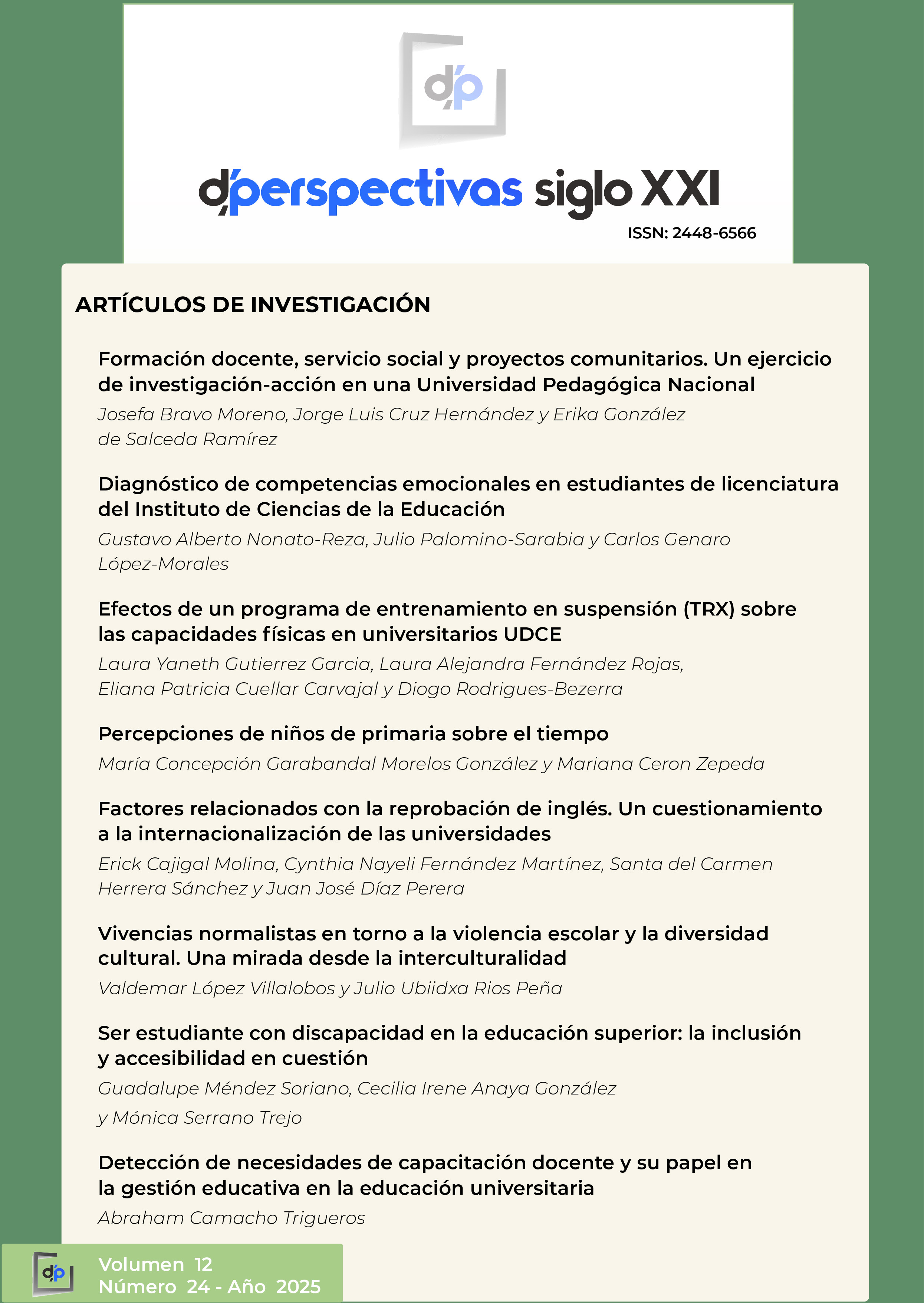Efectos de un programa de entrenamiento en suspensión (TRX) sobre las capacidades físicas en universitarios UDEC
Resumen
El entrenamiento en suspensión, que utiliza el peso corporal como resistencia, se centra en mejorar la fuerza muscular y la estabilidad postural de los participantes mediante el uso del sistema TRX. Objetivo: Evaluar los efectos de un programa de entrenamiento de suspensión de TRX sobre las capacidades físicas en estudiantes universitarios de la UDEC. Métodos: Se realizó un plan de entrenamiento en TRX, durante 12 semanas con ejercicios progresivos de miembros inferiores, superiores y core, para impactar en las capacidades físicas en los estudiantes. Se evaluaron las variables antropométricas peso, estatura, IMC, en las capacidades física, fuerza de miembros inferiores, fuerza de miembros superiores, zona abdominal y flexibilidad. Resultados: se revelaron mejoras significativas en la fuerza muscular y resistencia de los participantes. La fuerza prensil aumentó un 2.5 %, las flexiones incrementaron un 25 %, el salto horizontal mostró una mejora del 22.56 %, y el número de burpees subió un 17.77 %, con diferencias notables entre hombres y mujeres. Conclusiones: Un aumento notable en la fuerza muscular del tren superior e inferior, este estudio proporciona evidencia que el TRX es un método eficaz para mejorar las capacidades físicas en jóvenes universitarios, contribuyendo a un mejor rendimiento físico general. Además, destaca la importancia de continuar investigando en esta área para comprender mejor los beneficios de este tipo de entrenamiento en diferentes poblaciones.
Citas
Arrieta, A. (2021). Relación entre composición corporal, capacidad cardiorrespiratoria y resistencia muscular en bomberos varones peruanos. Revista Peruana de Ciencia de la Actividad Física y del Deporte, 8(2), pp. 1129-1138. https://rpcafd.com/index.php/rpcafd/article/view/137
Aspilcueta, J. (2021). Efecto de un programa de entrenamiento con TRX sobre la fuerza muscular en estudiantes universitarios. Revista de Ciencias del Deporte, 15(2), 1-12
Curiţianu, I., y Cătănescu, A (2017). Effects of Six-Week TRX Training on Physical Skills in Female Skier Students. European Proceedings of Social and Behavioural Sciences, pp. 1456-1460. https://doi.org/10.15405/epsbs.2017.05.02.178
EW Motion Therapy. (February 12th, 2023,). The Top Benefits of TRX Suspension Training. EW MOTION THERAPY. https://www.ewmotiontherapy.com/blog/benefits-trx-suspension-training#:~:text=TRX%20suspension%20training%20can%20strengthen,muscle%20group%20or%20skill%20level
Giovannucci, E., Rezende, L., & Hoon Lee, D. (2021). Muscle-strengthening activities and risk of cardiovascular disease, type 2 diabetes, cancer and mortality: A review of 1 prospective cohort studies. Journal of Internal Medicine, 290(4), pp. 789-805. https://doi.org/10.1111/joim.13344
Keating, X., Guan, J., Castro, J., & Bridges, D. (2005). A Meta-Analysis of College Students’ Physical Activity Behaviors. Journal of American College Health, 54(2), pp. 116-126. https://doi.org/10.3200/JACH.54.2.116-126
Leal, D. (8 de noviembre de 2021). How TRX training improves strength, balance, and flexibility. VERYWELL FIT. https://www.verywellfit.com/trx-suspension-training-4580454
Mate, J. (2014). En IPCC, 2014: Climate Change 2014: Synthesis Report. Contribution of Working Groups I, II and III to the Fifth Assessment Report of the Intergovernmental Panel on Climate Change [Core Writing Team, R.K. Pachauri y L.A. Meyer (eds.)]. IPCC, Ginebra, Suiza, pp. 117-130
Mohamed, S., & Mahmoud, R. (2021). The effect of using TRX training on some physical characteristics and the digital level of the triple jump for secondary school students in Aswan. The Scientific Journal Specialized Physical and Physical Education Sciences, 10(2), pp. 259-278. https://doi.org/10.21608/pemas.2021.192726
Melrose, D., & Dawes, J. (2015). Resistance Characteristics of the TRX Suspension Training System at Different Angles and Distances from the Hanging Point. Journal Of Athletic Enhancement, 4(1), pp. 2-5. https://doi.org/10.4172/2324-9080.1000184
Morales, J., Rondan, M., Olivo, J., & Burgos, D. (2023). Actividad física para el desarrollo integral de la mujer entre 18 a 40 años en el escenario covid-19. RIAF. Revista Internacional de Actividad Física, 1(2), pp.35-49. https://doi.org/10.53591/riaf.v1i2.178
Nalbant, Ö., & Kinik, A. M. (2018). The Effect of Suspension Workout on Agility and Forces Performance in Elite Basketball Players. Journal of Education and Training, 6(6), pp. 128-133. https://doi.org/10.11114/jets.v6i6.3257
Neira, A. (2023). Influencia de un programa de entrenamiento con TRX en la fuerza del tren inferior en estudiantes universitarios. Revista de Actividad Física y Salud, 18(3), 7-15
Özdal, M., & Biçer, M. & Pancar, Z. (2019). Effect of an eight-week core strength training on one-leg dynamic balance in male well-trained athletes. Biology of Exercise, 15(1), pp. 125-136. https://openurl.ebsco.com/EPDB%3Agcd%3A4%3A22829860/detailv2?sid=ebsco%3Aplink%3Ascholar&id=ebsco%3Agcd%3A137408612&crl=f&link_origin=www.google.com
Pancar, S., Topçu, H., Arabacı, R., & Vardar, T. (2021). The Effect of TRX Suspension Training on Physical Capacity of young Sedentaries. The Journal of Eurasia Sports Sciences and Medicine, 3(1), pp. 24–32. https://dergipark.org.tr/en/download/article-file/1725860
Smith, L. E., Snow, J., Fargo, J. S., Buchanan, C. A., & Dalleck, L. C. (2016). The Acute and Chronic Health Benefits of TRX Suspension Training in Healthy Adults. International Journal of Research in Exercise Physiology, 11(2), pp. 1-15. https://ijrep.org/the-acute-and-chronic-health-benefits-of-trx-suspension-training-in-healthy-adults/
Şenol, M., & Gülmez, İ. (2017). Effects of Functional Exercise Band (TRX) and Body Weight Resistance Training on Swimming Performance. Istanbul University Journal of Sport Sciences, 7(1), pp. 62-75. https://www.rissjournal.org/en/effects-of-functional-exercise-band-trx-and-body-weight-resistance-training-on-swimming-performance-13137#:~:text=In%20conclusion%2C%20resistance%20exercises%20with,programmes%20in%20their%20regular%20training
Snarr, K. A., Stites, K. D., Miller, K. R., & Sager, J. C. (2014). Predicting student success in an online general psychology course. Journal of Educators Online, 11(2). https://www.thejeo.com/archive/2014/winter/snarr_stites_miller_sager
Suchomel, T. J., Nimphius, S., & Stone, M. H. (2016). The Importance of Muscular Strength in Athletic Performance. Sports Medicine, 46(10), pp. 1419-1449. https://doi.org/10.1007/s40279-016-0486-0
Itzhak, I., Vingron, N.,Baum, S. & Titone, D., (2017). Bilingualism in the real world: How proficiency, emotion, and personality in a second language impact communication in clinical and legal settings. Translational Issues in Psychological Science, 3(1), 48-65. https://doi.org/10.1037/tps0000103
Vargas, N. (2023). Calistenia progresiva, método de acondicionamiento físico utilizado en la asignatura de Cultura Física para los grupos de 6º semestre de la preparatoria Emiliano Zapata de la BUAP. [Tesis de licenciatura]. Repositorio de la Benemérita Universidad de Puebla. https://hdl.handle.net/20.500.12371/20991
Derechos de autor 2024 D´Perspectivas Siglo XXI

Esta obra está bajo licencia internacional Creative Commons Reconocimiento-NoComercial 4.0.








